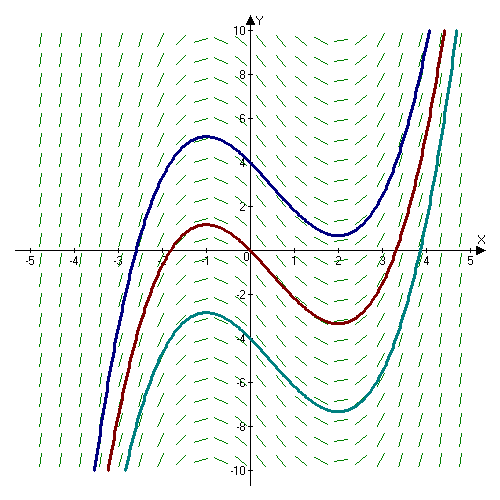
In
calculus
Calculus, originally called infinitesimal calculus or "the calculus of infinitesimals", is the mathematics, mathematical study of continuous change, in the same way that geometry is the study of shape, and algebra is the study of generalizati ...
, an antiderivative, inverse derivative, primitive function, primitive integral or indefinite integral of a
function is a
differentiable function
In mathematics, a differentiable function of one real variable is a function whose derivative exists at each point in its domain. In other words, the graph of a differentiable function has a non- vertical tangent line at each interior point in ...
whose
derivative
In mathematics, the derivative of a function of a real variable measures the sensitivity to change of the function value (output value) with respect to a change in its argument (input value). Derivatives are a fundamental tool of calculus. ...
is equal to the original function . This can be stated symbolically as . The process of solving for antiderivatives is called antidifferentiation (or indefinite integration), and its opposite operation is called ''differentiation'', which is the process of finding a derivative. Antiderivatives are often denoted by capital
Roman letters such as and .
Antiderivatives are related to
definite integral
In mathematics, an integral assigns numbers to functions in a way that describes displacement, area, volume, and other concepts that arise by combining infinitesimal data. The process of finding integrals is called integration. Along with ...
s through the
second fundamental theorem of calculus: the definite integral of a function over a
closed interval where the function is Riemann integrable is equal to the difference between the values of an antiderivative evaluated at the endpoints of the interval.
In
physics
Physics is the natural science that studies matter, its fundamental constituents, its motion and behavior through space and time, and the related entities of energy and force. "Physical science is that department of knowledge which ...
, antiderivatives arise in the context of
rectilinear motion (e.g., in explaining the relationship between
position,
velocity
Velocity is the directional speed of an object in motion as an indication of its rate of change in position as observed from a particular frame of reference and as measured by a particular standard of time (e.g. northbound). Velocity i ...
and
acceleration
In mechanics, acceleration is the rate of change of the velocity of an object with respect to time. Accelerations are vector quantities (in that they have magnitude and direction). The orientation of an object's acceleration is given by ...
).
The
discrete equivalent of the notion of antiderivative is
antidifference.
Examples
The function
is an antiderivative of
, since the derivative of
is
, and since the derivative of a
constant is
zero
0 (zero) is a number representing an empty quantity. In place-value notation such as the Hindu–Arabic numeral system, 0 also serves as a placeholder numerical digit, which works by Multiplication, multiplying digits to the left of 0 by th ...
,
will have an
infinite number of antiderivatives, such as
, etc. Thus, all the antiderivatives of
can be obtained by changing the value of in
, where is an arbitrary constant known as the
constant of integration
In calculus, the constant of integration, often denoted by C (or c), is a constant term added to an antiderivative of a function f(x) to indicate that the indefinite integral of f(x) (i.e., the set of all antiderivatives of f(x)), on a connecte ...
. Essentially, the
graphs of antiderivatives of a given function are
vertical translations of each other, with each graph's vertical location depending upon the
value
Value or values may refer to:
Ethics and social
* Value (ethics) wherein said concept may be construed as treating actions themselves as abstract objects, associating value to them
** Values (Western philosophy) expands the notion of value beyo ...
.
More generally, the
power function has antiderivative
if , and
if .
In
physics
Physics is the natural science that studies matter, its fundamental constituents, its motion and behavior through space and time, and the related entities of energy and force. "Physical science is that department of knowledge which ...
, the integration of
acceleration
In mechanics, acceleration is the rate of change of the velocity of an object with respect to time. Accelerations are vector quantities (in that they have magnitude and direction). The orientation of an object's acceleration is given by ...
yields
velocity
Velocity is the directional speed of an object in motion as an indication of its rate of change in position as observed from a particular frame of reference and as measured by a particular standard of time (e.g. northbound). Velocity i ...
plus a constant. The constant is the initial velocity term that would be lost upon taking the derivative of velocity, because the derivative of a constant term is zero. This same pattern applies to further integrations and derivatives of motion (position, velocity, acceleration, and so on).
Thus, integration produces the relations of acceleration, velocity and
displacement:
:
:
Uses and properties
Antiderivatives can be used to
compute definite integrals, using the
fundamental theorem of calculus
The fundamental theorem of calculus is a theorem that links the concept of differentiating a function (calculating its slopes, or rate of change at each time) with the concept of integrating a function (calculating the area under its graph, ...
: if is an antiderivative of the
integrable function over the interval
 In
In  In
In